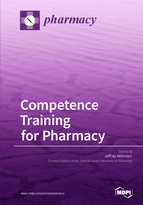Competence Training for Pharmacy
A special issue of Pharmacy (ISSN 2226-4787). This special issue belongs to the section "Pharmacy Education and Student/Practitioner Training".
Deadline for manuscript submissions: closed (31 January 2017) | Viewed by 93052
Special Issue Editor
Interests: pharmacy education and training; bibliometrics
Special Issues, Collections and Topics in MDPI journals
Special Issue Information
Dear Colleagues,
I would like to invite you to contribute to a Special issue on “Competence Training for Pharmacy” to be published in the online journal pharmacy (https://www.mdpi.com/journal/pharmacy). Although pharmacy is a relatively new journal, it is already indexed by the “Emerging Sources Citation Index (ESCI)”, the core collection of Web of Science.
This Special issue will include contributions from researchers from all over the world dealing with a variety of issues such as:
- The philosophy behind the production and use of competence frameworks
- The production of consensual competence frameworks
- Experience with the use of competence frameworks in pharmacy education and training
- Future developments in competence training for pharmacy students
Contributions can be in the form of reviews or research articles and should be 10–20 pages (A4) long, with 10-20 bibliographic references and several figures (graphs, flow-charts...). They will be reviewed by the editorial board and peer reviewed in the usual fashion. The whole collection will be published in book form.
Jeffrey Atkinson
Guest Editor
Manuscript Submission Information
Manuscripts should be submitted online at www.mdpi.com by registering and logging in to this website. Once you are registered, click here to go to the submission form. Manuscripts can be submitted until the deadline. All submissions that pass pre-check are peer-reviewed. Accepted papers will be published continuously in the journal (as soon as accepted) and will be listed together on the special issue website. Research articles, review articles as well as short communications are invited. For planned papers, a title and short abstract (about 100 words) can be sent to the Editorial Office for announcement on this website.
Submitted manuscripts should not have been published previously, nor be under consideration for publication elsewhere (except conference proceedings papers). All manuscripts are thoroughly refereed through a single-blind peer-review process. A guide for authors and other relevant information for submission of manuscripts is available on the Instructions for Authors page. Pharmacy is an international peer-reviewed open access semimonthly journal published by MDPI.
Please visit the Instructions for Authors page before submitting a manuscript. The Article Processing Charge (APC) for publication in this open access journal is 1800 CHF (Swiss Francs). Submitted papers should be well formatted and use good English. Authors may use MDPI's English editing service prior to publication or during author revisions.
Keywords
- competence
- pharmacy
- healthcare
- professional practice
- education
- policy






